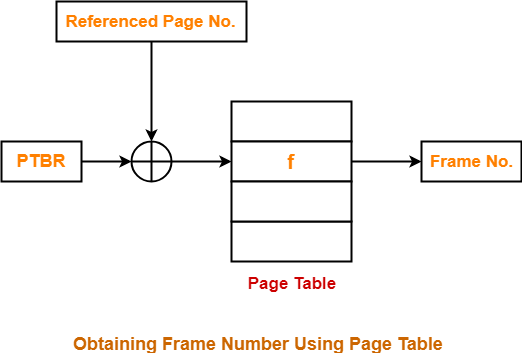How To Use Page Table Base Register
Paging in OS-
Before you go through this commodity, brand sure that you accept gone through the previous commodity on Paging in Bone.
We accept discussed-
- Paging is a not-contiguous retention allocation technique.
- The logical address generated by the CPU is translated into the physical accost using the page tabular array.
In this commodity, nosotros will discuss nigh Folio Table.
Page Tabular array-
- Page tabular array is a data structure.
- It maps the folio number referenced by the CPU to the frame number where that folio is stored.
Characteristics-
- Folio tabular array is stored in the primary retentivity.
- Number of entries in a page tabular array = Number of pages in which the process is divided.
- Page Tabular array Base Register (PTBR) contains the base address of page tabular array.
- Each process has its own independent page table.
Working-

- Page Tabular array Base Annals (PTBR) provides the base of operations address of the page table.
- The base address of the folio table is added with the folio number referenced by the CPU.
- It gives the entry of the page tabular array containing the frame number where the referenced page is stored.
Page Table Entry-
- A page tabular array entry contains several information nearly the folio.
- The data contained in the page table entry varies from operating arrangement to operating organisation.
- The most important information in a page table entry is frame number.
In general, each entry of a page table contains the following information-

ane. Frame Number-
- Frame number specifies the frame where the folio is stored in the principal retention.
- The number of $.25 in frame number depends on the number of frames in the primary memory.
2. Nowadays / Absent Flake-
- This bit is also sometimes called as valid / invalid bit.
- This bit specifies whether that page is present in the main memory or non.
- If the page is non present in the chief memory, then this bit is set to 0 otherwise set up to 1.
NOTE
- If the required page is not present in the main retentivity, and then it is called as Page Fault.
- A page error requires page initialization.
- The required page has to be initialized (fetched) from the secondary retentiveness and brought into the main memory.
3. Protection Fleck-
- This bit is also sometimes called as "Read / Write bit".
- This bit is concerned with the page protection.
- It specifies the permission to perform read and write operation on the page.
- If only read functioning is allowed to be performed and no writing is allowed, then this flake is set to 0.
- If both read and write performance are allowed to be performed, then this bit is set to 1.
4. Reference Chip-
- Reference bit specifies whether that page has been referenced in the terminal clock cycle or not.
- If the page has been referenced recently, then this scrap is set to 1 otherwise set to 0.
NOTE
- Reference flake is useful for page replacement policy.
- A folio that has not been referenced recently is considered a good candidate for page replacement in LRU folio replacement policy.
5. Caching Enabled / Disabled-
- This bit enables or disables the caching of folio.
- Whenever freshness in the data is required, then caching is disabled using this bit.
- If caching of the page is disabled, so this chip is set to one otherwise gear up to 0.
vi. Dirty Bit-
- This bit is also sometimes called as "Modified chip".
- This chip specifies whether that page has been modified or non.
- If the page has been modified, and so this chip is fix to 1 otherwise gear up to 0.
NOTE
In instance the folio is modified,
- Before replacing the modified page with another page, it has to be written back in the secondary retention to avert losing the data.
- Dingy chip helps to avert unnecessary writes.
- This is because if the page is non modified, then it tin can be directly replaced by another page without whatever need of writing it back to the deejay.
To gain improve understanding about Page Table Entry,
Watch this Video Lecture
Next Commodity- Paging Of import Formulas
Become more than notes and other study material of Operating System.
Watch video lectures by visiting our YouTube channel LearnVidFun.
Summary

Article Name
Page Tabular array | Paging in Operating System
Description
Paging in OS uses a data construction called as page table. Page Table stores the frame number where pages of the process are stored. Page Table Entry contains several data near the page. Page Tabular array Entry Format.
Author
Akshay Singhal
Publisher Name
Gate Vidyalay
Publisher Logo

Source: https://www.gatevidyalay.com/page-table-paging-in-operating-system/
Posted by: heitmannhation1977.blogspot.com


0 Response to "How To Use Page Table Base Register"
Post a Comment